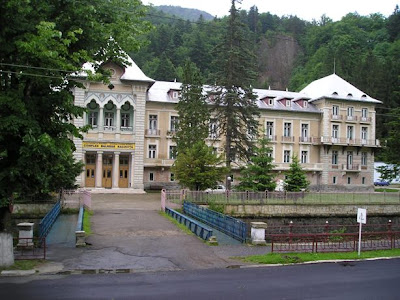
The first written evidence about Slănic Moldova is contained by the ancient sealed deed issued by Constantin Cehan Racoviţă on January 1, 1757. The first mineral water spring has been discovered in the year 1800 by cavalry commander Mihai Spiridon, during a bear hunt in the forests of Slanic. He sent water samples for analysis and, being convinced by its importance and he continued searching, discovering one year later the springs no. 3, 4 and 5.

Around 1808, having the approval of lord Scarlat Calimachi, moved here 12 families of peasants from the salt mines region, with the purpose of being caretakers for the two small houses built for those who came here for treatment and spa. In 1816, the Moldavian scholar and metropolitan bishop, Veniamin Costache, visited Slănic and that was the occasion when the first log houses were built; then there were build guest houses, spas for patients and a small church. In 1825, the ruler Ioniţă Sandu Sturza agreed upon an increase up to 27 families moved here to take care of the healing springs. This way started the population of Slanic Valley; the villages of Cerdac and Satul Nou were established. In 1840, the resort was featured for the first time on a map, under the name of “Feredeiele Slănicului” (Slănic Spas).

In 1887 the locality planning started and were built new buildings, modern installations and baths, bridges and culverts, spring intakes were established. All this contributed to the international fame of Slănic Moldova resort from the late 19th century. After World War I, the town had become a ruin. The restoration began late, major repairing was done with great effort and the church was rebuilt from scratch.

By means of its climatic features (pure air, rich in aerosols, resins and negative
oxygen ions), and the flow of ozonated air and forest aroma aerosols, the resort
benefits from a relaxing and refreshing climate that in the same time calms down and stimulates the body. The quality of the natural environment, the complete preservation of the ecological system and scenery of the area is the main support for tourist activities, mountaineering, leisure time and prevention or curing treatments. Slănic Moldova is one of the 12 spa resorts of national importance with mineral springs that have received awards in many international contests - Frankfurt (1881), Vienna (1973), Paris (1889).

The spa potential is the key element in selecting resorts and this is assessed by the nature and availability of resources. The presence of natural therapeutic factors for treatment triggers the organization of three types of medical care: prophylaxis, treatment and functional recovery. In this case, the potential consists of water quality, their highly therapeutic value and proper water flow capacity, valued as reserves. This has determines the spa feature of the resort, appropriate for the treatment of digestive diseases, accessory digestive glands, respiratory system, nutrition and metabolism diseases.

Slănic Moldova offers the possibility of having internal treatment with mineral water, aerosols and inhalation, having the equipment for warm baths with mineral waters, pools for kineto-therapy, equipment for electro and hydro-therapy, gyms, mofettes, treatment with Gerovital. The spa features of the resort are quite unique in Europe, with a high variety of springs from the point of view of composition, concentration, chemical complexity and therapeutic effects, all gathered in a quite small area.



0 comments:
Post a Comment